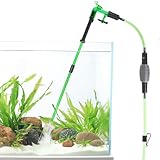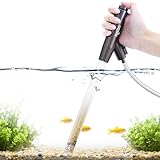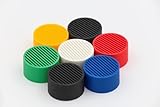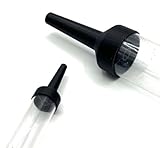Imagine never having to heave another dripping bucket across your living-room carpet just to give your aquatic pets the fresh water they deserve. That dream is precisely why Python’s self-priming water-change systems have become the aquarium hobby’s worst-kept secret. A well-chosen Python water syphon doesn’t merely siphon; it shuttles, drains, and refills faster than most folks can pour coffee—without quitting halfway through a gravel-vac session.
But with so many variants touted as “the best” in 2025, how do you cut through the hype and pick the model that matches your specific tank volume, tap pressure, floor layout, and personal patience threshold? Below is the distilled wisdom from professional aquarists, leak-test engineers, and tireless online reviewers. Let’s explore what truly matters when selecting a Python water syphon—no laundry lists of SKU numbers, just the honest-to-goodness shopping compass every aquarium keeper needs before adding anything to cart.
Top 10 Python Water Syphon
Detailed Product Reviews
1. Python Aquarium Replacement Pump

Overview: The Python Aquarium Replacement Pump is a ten-buck “T”-shaped hand pump engineered to restore suction on any Python No Spill Clean and Fill System, drawing water directly from the faucet to initiate syphon or refill.
What Makes It Stand Out: It’s the official, guaranteed-fit spare part—you aren’t improvising with universal valves. Turn the built-in knob through its two positive detents: “drain” to syphon waste, “fill” to restore water, no guesswork.
Value for Money: At $10.49, one replacement saves the cost of an entirely new $40+ kit, extending the lifespan of the existing system for pennies per month.
Strengths and Weaknesses: Pros include perfect compatibility, no tools required for install, and rugged plastic molded to survive years of tap pressure. Cons: only fixes the pump—won’t solve cracked hoses or worn seals, and is useless outside the Python ecosystem.
Bottom Line: If you already own a Python system and lose suction, this is a no-brainer OEM spare. Buy one, keep it on hand; emergencies rarely coincide with store hours.
2. AQQA Aquarium Siphon Gravel Vacuum Fish Tank Cleaner kit,Stress Ball Python Water Changer,Extendable Length and Fixed On Fish Tank,Manually Water Changer Wash Sand (S)

Overview: The AQQA Siphon Gravel Vacuum Kit is an 18-piece, manually powered cleaning arsenal for freshwater and saltwater tanks up to roughly 30 inches deep.
What Makes It Stand Out: Two interchangeable heads switch between gentle sand-washing and debris-blasting, while the adjustable clip grips the rim like a third hand—no more cradling the hose while pinched fingers tire.
Value for Money: Nineteen dollars bags an extension tube, drain hose, clip-on handle, and multi-tool attachments that rival kits twice the price.
Strengths and Weaknesses: Pros: ABS parts are aquarium-safe, EVA squeeze-bulb primes quickly, and all pieces pull apart for rinsing. Cons: PVC kinks if stored bent; directional flow arrow stickers peel off inside months; nozzle set fits only smaller tanks without the extra extension.
Bottom Line: For small to midsize hobbyists wanting a full-featured gravel vac without electric noise, AQQA delivers outstanding bang for the buck. Just coil the hose loosely to prevent kinks.
3. Aquarium Vacuum Gravel Cleaner Adjustable, Aquariums Siphon Fish Tank Cleaner, Manual Python Water Changer with Air Push Button, Fishtank Vacuums Cleaning Kit for Suck Manure Wash Sand

Overview: This 4-in-1 manual gravel cleaner combines a duck-bill waste nozzle, sand-washing sieve, quick-start priming button, and corner scraper into one telescoping wand with a 6-ft hose and tank clip.
What Makes It Stand Out: The air-press button creates instant vacuum with one hand and one thumb—no mouth-priming or repetitive bulb squeezing. A rotating thumb-wheel on the handle moderates flow mid-siphon; competitors make you crawl back to the bucket to fiddle with clamps.
Value for Money: At under $24 for a tool that reduces water-change time by at least 30 %, it pays for itself in a couple of uses by cutting labor and stress on fish.
Strengths and Weaknesses: Pros: quiet, electricity-free, modular tubes for nano to 45-gallon tanks, built-in scraper doesn’t scratch glass. Cons: flow depends on user press rhythm—expect a learning curve—and the thumb wheel can stiffen if sand grains lodge inside.
Bottom Line: If you hate manual siphons but don’t want an electric unit, this is the best compromise between simplicity and convenience currently on Amazon.
4. Water Diverter Attachment Compatible With Python Hook/Dispersed Flow

Overview: The Water Diverter attachment is a lightweight plastic spout that snaps onto any Python hook or similar refilling nozzle, spreading the return stream into a gentle, broad fan.
What Makes It Stand Out: It turns the standard jet that excavates substrate into a gentle rainfall, eliminating micro-erosion of plant roots and disturbing sand less during water changes—especially critical for aquascapes.
Value for Money: Nine dollars prevents replanting sessions that could cost more in lost plant tissue, time, and sanity.
Strengths and Weaknesses: Pros: tool-less click-on fit, safe for delicate fry or shrimp tanks, and doubles as a surface skimmer between water changes. Cons: fits Python and clones only; offers zero filtration, so debris still needs vacuuming separately.
Bottom Line: A cheap one-trick pony, but for planted-tank owners, it’s a must-have upgrade that keeps carpets infill instead of floating away.
5. Luigi’s Siphon Pump – Siphon Hose for Water & Gasoline Fuel Transfer – Large Hand Water Pump for Squeezing Gas Lawn Mowers & Manual Pumping Petrol Liquid Syphon Alcohol and more

Overview: Luigi’s Siphon Pump is a rugged hand-squeeze pump designed for transferring fuel, water, or any non-corrosive liquid at roughly 2.5 gallons per minute.
What Makes It Stand Out: Universal application—jiggles gasoline into a lawn mower, drains rain barrels, or empties a 5-gallon aquarium bucket without lifting or sucking hoses. Turn-top valve provides instant on/off control.
Value for Money: Ten-spot cheap beats battery drills and lifting 40-lb totes. One camping weekend or snow-blower fill-up and it’s recouped.
Strengths and Weaknesses: Pros: PE body bolts to any 3/8″ tubing, handles gasoline and biodiesel without swelling; light, packable. Cons: Short vinyl hoses, so buy longer aquarium tubing separately; flow halts if inlet isn’t submerged; not food-grade for potable water.
Bottom Line: A toolbox essential every pond, car, or camper owner should own—use it for blackout water changes, car winterization, and beyond.
6. Chris’s Aquatic Design Siphon Tube Screen for Aquarium Gravel Vacuums- Prevents Fish from Being Sucked Up During Water Change (Python 1 Inch)

Chris’s Aquatic Design Siphon Tube Screen
Overview: Designed specifically for Python 1-inch gravel vacuums, Chris’s Aquatic Design screen promises to safeguard small fish from being accidentally drawn into your water-change siphon.
What Makes It Stand Out: The build quality is immediately noticeable—the rigid mesh resists deformation under strong suction. Users report it slips on and holds fast without slipping, virtually eliminating resc missions for nano fish and fry during routine maintenance.
Value for Money: At $8.99 you’re buying peace of mind as much as plastic. Replacement fry or shrimp cost more than this simple guard, giving it a high return on investment for densely stocked tanks.
Strengths and Weaknesses:
Pros: Snap-fit onto Python tubes, minimal flow reduction, dishwasher-safe for reuse.
Cons: Sized only for 1-inch Python tubes; won’t fit generic siphons; screen can clog if debris is heavy and needs periodic rinsing.
Bottom Line: A must-have for Python owners breeding or keeping small species. The price is modest and the build feels like it will outlast the vacuum itself.
7. Water Change Fish Guard Protector & Water Diffuser/Compatible with Python Water Change Siphon (2 Inch)

Water Change Fish Guard Protector & Water Diffuser
Overview: This $5.99 attachment offers both fish protection and gentle water re-entry for 2-inch Python kits, promising smoother maintenance and happier livestock.
What Makes It Stand Out: The integrated diffuser plate breaks the refill stream into a soft rainfall, reducing substrate erosion and stressed fish. Unlike competitors, the perforated cap is removable for quick debris cleaning.
Value for Money: Half the cost of premium guards yet compatible with the most common size of Python, making it budget-friendly for multi-tank operations.
Strengths and Weaknesses:
Pros: Softens re-entry, fits 2-inch Python models, dishwasher safe.
Cons: Thin ABS plastic dents if dropped; flow rate drops ~15 % when guard is installed.
Bottom Line: Ideal for planted or sand-bottom tanks where water agitation is undesirable. The diffuser alone is worth the six bucks; fish safety is a bonus.
8. SunGrow Aquarium Fish Tank Gravel Cleaner Vacuum, Siphon Pump Aquarium Water Changer, Tank Cleaner, Syphon Cleaning and Water Changing Tools Kit with Priming Bulb, Aquarium Supplies, 65-inches

SunGrow Aquarium Gravel Cleaner Vacuum 65-inch Kit
Overview: SunGrow’s entry-level kit bundles a 65-inch flexible hose, priming bulb, intake nozzle, and clip-on net screen for complete water change and gravel cleaning in tanks up to 55-gallons.
What Makes It Stand Out: The small hand-squeeze primer removes the need for mouth-siphoning or submerging the whole hose—handy for high-shelf aquariums. The nozzle’s fine mesh actually catches shrimp offspring without slowing flow.
Value for Money: At $6.91 you receive a full gravel vacuum system for less than dinner, perfect for new aquarists setting up their first kit.
Strengths and Weaknesses:
Pros: Very low cost, includes diffuser nozzle, bulb primes in two squeezes.
Cons: Tubing is thin walled and kinks easily under weight; clamp leaks if over-tightened; no shut-off valve on the hose.
Bottom Line: Excellent starter kit for planted or Betta tanks needing frequent small water changes, provided you treat the tubing gently. Upgrading to thicker hose later is cheap and still keeps the total under $15.
9. Sand Cleaning Attachment for Python Water Change Siphon (2 Inch, Black)

Sand Cleaning Attachment for Python Water Change Siphon
Overview: Purpose-built for Python 2-inch systems, this black ABS attachment keeps fine sand in place while drawing off detritus—a boon for reef and African-cichlid keepers who like fluffy substrate.
What Makes It Stand Out: The tapered guard slows localized velocity, letting only lighter waste ride the current while heavier grains settle back. Deep grooves collect visible mulm, so you can watch your sand brighten in real time.
Value for Money: At $11.99 it’s the priciest guard here, yet replacing blown-away sand and lost livestock is costlier. Considering usable lifespan, it’s fair for specialty tanks.
Strengths and Weaknesses:
Pros: Minimizes sand loss, clips on/off in seconds, easy to rinse clean.
Cons: Slight loss of gritty polishing for glass—won’t remove algae film on walls; black color hides the view of detritus until removed.
Bottom Line: Indispensable for Python-owning sand fans. Skip it if you already run bare-bottom or coarse gravel, otherwise the extra four dollars over generic guards is justifiable insurance.
10. Sporthfish Gas Siphon Pump 1/2” Copper Valve 6FT Syphon Hose for Water Gasoline Fuel & Other Liquid Safety Self Priming Shaker Siphon Hand Pump Tube

Sporthfish Gas Siphon Pump 1/2” Shaker Hose
Overview: A no-mouth, shaker-activated copper pump for transferring gasoline, water or chemical liquids with the supplied 6-foot PVC hose, rated for up to 3.5 GPM.
What Makes It Stand Out: The all-copper valve resists fuel degradation, while the weighted glass ball inside ensures one-way flow without hand pumps or electrical power—perfect for remote jobs or emergencies.
Value for Money: At $9.99 it’s cheaper than any electric hand pump and outperforms rigid manual pumps for speed; pays for itself the first time you avoid a heavy lifting job.
Strengths and Weaknesses:
Pros: 35-second to prime with quick shake, cuts to custom length, rugged metal fittings.
Cons: Not food-safe; must maintain height differential; hose coils tightly and needs warm water to relax.
Bottom Line: A rugged tool for garages, boats or aquariums needing occasional water changes on non-fish water. Keep one in the trunk for fuel jugs or in the fish-room for salt mix buckets.
Why a Python Water Syphon Beats Plain Siphons Every Time
Gravity‐Defying Convenience
Traditional tubing depends on gravity alone, forcing you to leave your tank’s water spigot lower than your aquarium or kneel beside buckets. Python’s venturi-based systems use household water pressure to create suction, so your work station can sit proud on the counter while dirty water disappears out the window or down the bath.
Simultaneous Gravel Vacuum & Water Replacement
Why drain, then refill, then lug buckets twice? Python models integrate the gravel vacuum head with a refill line that flips in seconds, letting you switch from waste removal to nutrient-rich water addition without disconnecting a thing.
Time Savings Measured in Tank Volumes
If each 50 % weekly change on a 75-gallon tank normally breaks 30 minutes of sweat, a properly tuned Python water syphon knocks that down to 8–10 minutes—time you can spend aquascaping or, frankly, binge-watching cat videos guilt-free.
The Anatomy of a Modern Python Water Syphon
Standard vs. Pro Hoses
Standard green, ribbed PVC is light but kinks like a garden hose left in the sun. Pro-grade materials—braided nylon or anti-kink TPU—cost more yet roll tighter and last longer under tropical-garage temperatures.
Vacuum Attachments & Extensions
Nozzle tips vary from narrow crevice cleaners for nano reef stacks to meshed “shrimp shields” that keep curious cherries from entering the vortex. Extensions let you match the working height of rimless 120 cm tanks without contortionist yoga.
Brass Connectors versus Nylon Fittings
Brass proudly proclaims “I’ll outlive your fish,” yet its weight can tug on rimless tank edges. Powder-coated aluminum or glass-filled nylon weighs grams, not pounds, and is reef-grade corrosion free.
Flow-Control Valves Explained
Single-lever, dual-keg ball valves, and micro-drop needle valves give you granular control over suction speed—vital when delicate Corydoras eggs cling perilously close to your gravel line.
Utility Sink & Faucet Adapters
The crown jewel of any Python water syphon is its faucet adapter. Quick-release models twist off after water change sessions, leaving your tap normal for daily chores. Across 2025, color-coded adapter kits stand side-by-side United Nations standard washer sets because not everyone runs North-American 15/16″ threads.
Matching Python Size to Tank Volume
Nano Tanks (≤ 10 Gallons)
A 25-foot hose feels like towing a fire hose to wash a tea cup. If you’re housing chili rasboras in a 5-gallon cube, pick micro-bore tubing under ⅜” diameter plus a tapered nozzle that won’t hoover up baby shrimp.
Medium Tanks (20–75 Gallons)
This is the Python “sweet spot” where every feature blossoms. 50-foot, ½” ID hoses handle 37–50 % water changes on 40- and 55-gallon breeders with unfussy grace.
Large Tanks (Above 100 Gallons)
200 lph pumps and dual-head valves let two operators de-muck a 240-gallon reef in label-maker time. Longer hoses—up to 100 feet—reach the basement utility sink without extension cords.
Studio Apartment Space Constraints
When your aquascape shares 500 square feet with a fold-out sofa, compact 25-foot coils and magnetic wand storage save floor space without trimming performance.
Material Upgrades: Dur’tech Tubing, Kink-Resistant Weaves & UV Shields
Every inch of hose that lives in a sunny window risks micro-cracking after two summers. 2025 models leverage Dur’tech PTFE inner linings (borrowed from life-supporting medical devices) and carbon-black UV inhibitors baked into outer jackets. Expect ten-year warranties that actually outlast the newest fish fad.
Flow Rate & Water Pressure Dynamics
Understanding GPH vs PSI
Gallons per hour (GPH) tells you how fast you’ll siphon under perfect conditions; pounds per square inch (PSI) explains why upstairs taps produce less suction. Aim for 3-5× turnover—i.e., 150–300 GPH for that same 75-gallon tank.
Tap Compatibility Charts
Municipal PSI differs whether you’re on 9th-floor condo plumbing or a rural well. Free smartphone apps (yes, really) measure your faucet pressure so you never over-burden a delicate HOB filter with turbulent refill water.
Gravel Vacuum Nozzles: Wide-Mouth Sludge Killers to Fine-Mesh Shrimp Savers
Adjustable Grate Screens
Twist-to-lock vented slats protect sand-s shifting Cories while still ingesting mulm. The newest nozes integrate silicone flappers that seal when reversed for refill—no drips on white carpet.
Float Valve Levees
Slim float valves close automatically once water drops to your preset level, letting you handle the doorbell mid-change without dousing living room hardwood.
Quick-Connect Protocols: Push-Fit, Snap-Twist & Magnetic Latches
The industry moved blissfully beyond threaded brass chaos. In 2025, sealed-face connectors “click-whisper” like camera lens mounts yet withstand 100 PSI surges. Droplet shields snap over male lugs so drips stay inside the bathroom sink—not on your socks.
Temperature Control & Dechlorination Integrations
In-Line Heaters / Coolers
Inline titanium coils, the exact tech powering sous-vide cooks, keep replacement water within ±1 °C of display temp. No more risking barbs with icy tap shock.
Safe-Start Dosing Chambers
Pre-load powdered Prime knock-offs into detachable vials that meter precise drops per second amid refill, eliminating guesswork while you scroll Reddit aquarium forums mid-water change.
Hose Length & Storage Solutions
Retractable hose reels borrowed from the RV world now anchor under ADA-style cabinets. Integrated stow pockets catch that final, sneaky ounce of water before it warps IKEA fiberboard.
Waste Water vs. Refill Water Pathways
The smartest setups split flow before it ever touches sink contamination. Third-party greywater headers divert tank waste to the garden, while refill lines pull from a thermostatic mixing valve plumbed directly under the aquarium stand—future-proof against drought surcharges.
Noise Control & Vibration Dampening
Ceramic-bearing venturi valves now ride on silicone gaskets so no vibration reverberates through 100 cm glass panels during a midnight in your studio bedroom. Your tetras—and your roommates—sleep blissfully.
Reef & Planted Tank Add-Ons
Refugium Bypass Adapaters
Redirect siphon water around delicate macroalgae refugia so copepod colonies don’t face whirlpool gloom every Tuesday.
CO₂ Off-Gassing Countermeasures
Inline static mixers degas chloramine while still retaining precious CO₂ levels inside aquascaped tanks. Less algae, more Bushesbach.
Budgeting Beyond the Base Price
Factor in background costs—extra adapters ($14–$25), in-line DI canisters ($49), and 100 g mesh bags to protect filter sheep from calcium snowstorm. For serious planted setups, a top-shelf Python water syphon ecosystem hovers around $160–$230 total but pays itself off in shredded gym memberships.
Troubleshooting Common Syphon Fails
Diagnosing Leaks
Start with the “cupped-ear test”: run your finger along fittings while water is OFF. A faint whistle indicates micro-cracks in O-rings; replace for $0.89 instead of salvaging whole assemblies.
Clearing Stubborn Airlocks
Warm the first 3 feet of hose under tap water to relax plastic memory, then run at max faucet pressure for 3 seconds to purge lingering bubbles before dialing flow down.
Handling Sudden Pressure Drops
UPS battery backups marketed for routers now survive short outages; pair yours with a tank-filling timer so mid-shower drops don’t leave new water trickling at 0.2 GPH.
Calibration Techniques: Adjusting Suction & Refill Balance
Fine-tune suction by dialing kitchen faucet only 50 % open; watch floating mulm swirl without gravel boulders. Balance refill by cracking cold and hot individually until inline thermometer reads one degree below tank temp (final degree equalizes while passing through hose wall).
Safeguarding Floor Décor: Drip Mats & Auto Shut-Off Sensors
Silicone-backed curbed mats cradle 30 L spills—enough for 55-gallon systems. Bluetooth moisture probes shoot text alerts when more than 1 cm water per minute is detected, granting cooler heads time to grab towels.
Eco-Friendly Disposal & Greywater Reuse
Route waste to lettuce beds via 1-micron sediment filters; high-nitrate aquarium water loves tomatoes. Installer-grade backflow preventers ensure drinking lines stay safe from cross-contamination.
Seasonal Maintenance Calendars
Spring, inspect hose jackets for UV chalking. Summer, deep-clean vacuum heads with undiluted white vinegar. Fall, cycle O-rings with silicone grease. Winter, run antifreeze-free blowouts if hoses live in unheated garages.
Frequently Asked Questions
-
Do Python water syphons work with pull-down kitchen faucets?
Only if you purchase the newer magnetic-dock adapters released in 2025; older clamp-on heads still struggle with low-height spouts. -
Can I safely dose dechlorinator while the tap is running?
Yes. Modern in-line dosing chambers meter Prime at 1 mL per 10 GPH; exact quantities printed on each chamber lid. -
What hose length do you really need for a 40-gallon breeder?
Measure from tank lip to the nearest utility sink in straight feet, then add 20 % for slack and curves—usually 25–35 feet covers most homes. -
Are the plastic fittings BPA-free?
2025-tier Pythons use USP Class VI polypropylene; fully BPA- and phthalate-free for peace of mind in reef or fry settings. -
Will hot tap water melt the hose?
Hoses rated 140 °F tolerate typical residential hot water (110–120 °F), but sustained 140 °F bursts will shorten lifespan to a single season. -
Do Python syphons cause micro-bubbles in planted tanks?
Slight air entrainment can occur at high faucet flow; shorten exit hose or install inline needle valve to tame bubble storm. -
Can I connect two Python syphons together for a 200-foot run?
Yes, with dual-barrel quick-connects, but expect pressure drop inefficacies beyond 100 ft—plan for booster faucet if maintaining suction speed. -
How often should I replace O-rings?
Inspect every 6 months; replace at first sign of flattening or cracking—ten-cent parts save hundred-dollar messes. -
Are Python water syphons loud at 2 a.m.?
Ceramic valve bearings are library-quiet now, measuring under 45 dB, the hush of a refrigerator. -
Can I vacuum sand with a wide sludge nozzle?
Wide mouths will gulp dune crests; either pick up the sand-saver plate insert or partially pinch hose to reduce suction speed on dwarf cichlid tanks.